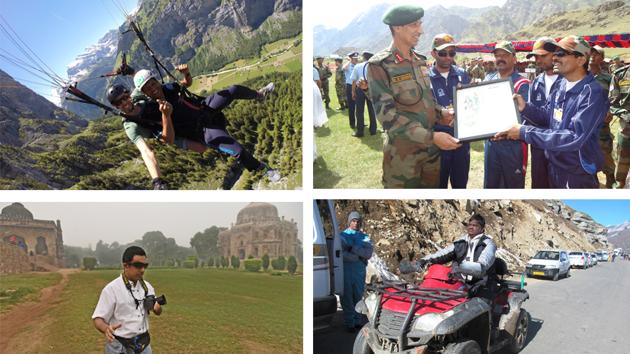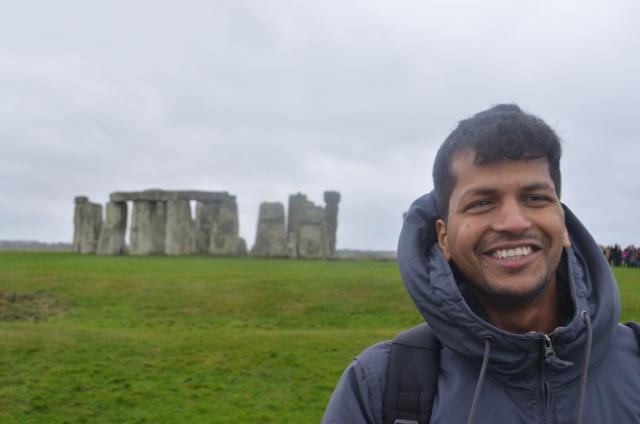Heard of sightseeing by sound? Meet India’s visually challenged travellers
What’s it like to skydive when you can’t see, feel and touch Stonehenge to imagine it? Find out...
What’s the first thing that comes to mind when you think of your last vacation? Chances are, it’s a beautiful view, an art work, perhaps your luxurious hotel room. Essentially, an image. So what is it like to travel when you cannot see?

That is the most common question visually challenged travellers face, they say. ‘How does a blind person sightsee?’
“Sightseeing is not really everything, because you can have a multi-sensory experience by just listening to a buzzing city and its local languages, taking in the various smells that make a lane distinct or just feeling the vibe of a quaint town,” says corporate executive Ekinath Khedekar, 32, who is visually challenged.
Take the time Khedekar jumped from a plane over the Swiss Alps. “It was exhilarating,” he says, of his skydiving trip last year. “I really don’t feel I missed out on anything because every minute sensation — the free-fall, air pressure, wind on my face, was there.”
While travelling with disability can be daunting, blind travellers say it’s all about getting over the initial inhibitions and fears.
Khedeker discovered his love for travelling after living in London as a post-graduate student. Mumbai-based visually challenged couple Joaquim and Padma Rapose travelled as a family while raising their children, and their daughter now often acts as their guide.
Pranav Lal from Delhi even uses an ‘artificial eye’, in the form of a sensory substitution device, to capture snapshots of his journeys. And Satish Navale from Kolhapur learnt that his tours across the country were a great way to make new friends.
Some travel with the help of sighted companions provided by travel agencies; others go on solo tours.
Delhi-based Planet Abled, launched last year, curates trips for people with disabilities, offering customised solo trips and group tours that often include enthusiastic abled travellers too.
UK-based international tour operator Traveleyes, launched in 2004, works on a similar model that pairs sighted with non-sighted travellers on luxury tours, in exchange for generous discounts for the former.
“Accessibility has been a major roadblock,” says Neha Arora, 33, who launched Planet Abled to help people like her parents — her father is visually challenged and her mother is a wheelchair user.
That’s starting to change. Some monuments now have Braille signs, others have 3D touch models of art works.
And where the technology hasn’t kept up with the travellers, there are travel buddies like start-up executive Anurag Maloo, 27, who signs up whenever Planet Abled is doing a tour of Delhi.
“It’s very fulfilling,” he says. “During a trip to Qutub Minar, I finished describing the architecture to a visually challenged boy and he said, ‘I can feel what you see’. That really made my day. Such trips have also changed the way I see places. I’ve started noticing minute details like sounds and smells.”
FROM UTTARAKHAND TO ICELAND
(Above) Pranav with another tourist who was a part of the Traveleyes team to Iceland.
As a child, Pranav Lal loved the sci-fi classic Journey to the Centre of the Earth. He listened to the audio book again and again. And he swore he would one day descend into a volcanic crater. In 2011, the cyber security consultant stumbled upon a package to Iceland by TravelEyes, a Leeds-based tour operator that organises trips for the visually challenged. It was time to make his dream come true.
“I was the only Indian among 15 people from around the world, challenged and sighted,” says the 38-year-old Delhiite. At TravelEyes, a sighted person is paired with a visually-impaired one for each day of the trip.
“It was 11 days of pure bliss,” says Lal, who ‘sight-sees’ using a partial vision sensory substitution device that converts images to sound. “From capturing a photo of the Skógafoss waterfall complete with a rainbow to standing at the edge of the Kerid crater, feeling the sculptures at the Einar Jónsson sculpture garden and navigating through rocks and streams in the Thingvellir national park, I experienced a whole new world there.”
Lal is an avid photographer, capturing images with his phone using a special device called vOICe, which works as an ‘artificial eye’ and helps him frame his shots. And he loves to trek.

His most daunting trip was a Himalayan trek to Dayara Bugyal in Uttarakhand, organised by the Tata Steel Adventure Foundation. “At one point we were all exhausted and it was getting dark fast. My sighted guide was panicking and wanted us to head back. I had a hard time convincing him to keep moving, and I eventually started leading the group,” he says. “It was an exhilarating experience. The toughest part was avoiding the pine trees, and keeping an ear out for the warning bells of mule trains that gallop towards you at great speed.”
Next on his list: Leh-Ladakh, the north-east, the US, Austria and Germany.
Favourite spots: The heritage transport museum in Tauru, Haryana, where I could feel things like stage coaches and sit in bullock-carts. I finally understood what Charles Dickens meant by ‘stage coach’.
SWAPPING MARATHI JOKES IN PRAGUE

Corporate executive Ekinath Khedekar had never given travel much thought until he went to Thailand with friends in 2013.
“We met up at the Bangkok airport, and standing in queue to get my visa on arrival etc, taught me that there was nothing to be anxious about even when travelling abroad,” says Khedekar, 32.
Then, in 2015, he gained admission to an Environmental Economics course at University College London, and that opened the floodgates. “On daily walks around my campus, exploring new parks and alleys, my confidence grew one block at a time,” he says.
A solo trip to Ipswich, about 100 km away, followed. “I hopped onto a yacht and went sailing,” he says. “The captain and his daughter taught me to use an accessible compass and gave me tips on steering a yacht. It was so much fun.”
Khedekar has since been to Amsterdam, Budapest and Prague with two visually challenged friends from Delhi, a trip that he calls mind-opening.
“Prague is ideal for people like us,” he says. “There are tours for the visually challenged, special guides for historical walks, underground ghost tours. We even went river zorbing and tandem-biking.”
Google Maps is a big help, he adds. “But Maps is not always right and we got lost several times, but we were never stranded. People always helped us out.”
At one point in Prague, he says, laughing, the architecture had them really confused between doors and walls. “We kept struggling to find a place to get dinner and ended up bumping into walls while joking in Marathi, and someone called out to us in Marathi!” he says. It turned out to be an Indian from Mumbai, who helped them out and stayed for dinner.
Favourite place: London, because of its accessible pavements and transport, disabled-friendly recreational centres, restaurants, theatres etc.
‘I TRAVEL TO MAKE FRIENDS’

The first time Satish Navale travelled solo, he was 19.
“The trip from Pune to Mumbai left me shaken. It was my first time on a train alone and I walked right off the platform and fell face-down on to the tracks,” says the education researcher from Kolhapur.
Navale, now 35, has been to 60 cities across India since then, mostly by himself.
“I worry about my safety, about losing my way, about being mugged or made fun of because I dare to go on journeys on my own. But that fear is not greater than my love for exploring new places and experiencing a new place through its sounds and smells. So, every few months, I dip into my savings, select a place and set off.”
His favourite trip so far has been to the Badami Bagh Cantonment area in Srinagar district, in 2004. “Everyone told me I was silly to go off on my own to a troubled region,” he says. “But little do they know the joys of making new friends along the way, excitement of finding your way through unknown lands.”
He remembers how a soldier offered him a lift from the bus stop. “People usually readily help you when you say you are disabled. Rarely have I come across someone who tried to take advantage of me,” he says.
He says the biggest drawback of travelling with visual impairment is not being able to see colour. “When people describe places to me, they mention the bright, blooming flowers or golden tops of temples, which I cannot imagine,” he says. But he is quick to add that his other senses pretty much make up for this. “The sounds of a waterfall, the way the air smells at a tea garden… each trip becomes special in its own way.”
Navale feels the number of friends he has made on his journeys is reason enough to continue. A diehard cricket fan, he went to Chennai in 2002 to cover the India-Pakistan Blind Cricket world cup for All India Radio. “The high point of the trip was meeting Pakistani cricketers, one of whom even gave me his watch, which remains a prized possession.”
Favourite spot: Dajipur Wildlife Sanctuary because of the sensory wildlife experience project started by my NGO Prerna in association with the Kolhapur wildlife department. It has information written in braille for those with visual impairment and has its own radio system that helps tourists identify the sound of the birds and detect medicinal plants through their smell.
COLLEGE SWEETHEARTS TURN TRAVEL BUDDIES
Bank executives Joaquim Rapose, 57, and his wife Padma, 54, met in college in 1982.
“We had a common reader and Joaquim was always making wisecracks that made me laugh,” recalls Padma. “I knew this man would make me laugh all my life.” They married in 1986 and then started their travels across the country.
They’ve been to Jammu and to Kanyakumari, Dharamsala to Wagah border. Sometimes they travel on their own, sometimes with their two children.
(Above) Bank executives Joaquim Rapose, 57, and his wife Padma, 54, pose near a waterfall in Kerala.
“In Kodiakanal, we couldn’t see the beauty of the pine forests, but the cold wind on my face and the fresh smell of greenery and chirpy birds made it extremely romantic,” says Padma. “Ladakh’s Rohtang Pass, I had heard, was so beautiful. I felt that beauty when I was sitting on some snow and it was freezing… and then I felt the rays of the sun on my head. And that feeling of being in two worlds at the same time, is the feeling I still carry in my mind.”
Their daughter Pearl, 29, who often serves as their guide, says her parents are ‘inquisitive tourists’. “I remember asking a monk at Dharamsala if my mother could touch his robe to feel the cloth… and he happily obliged,” she says, laughing. “People are usually very cooperative.”

Some are very curious. Joaquim says people come up to him and express bewilderment about how they manage to travel. “Sometimes, we become the centre of attention, which is part of being a visually challenged tourist,” he says. “But usually, people take it upon themselves to warn us about a step or a low ceiling ahead, and that is extremely heart-warming.”
Favourite spot: Himachal Pradesh. “I remember riding pillion on a mountain bike near the Rohtang Pass,” Joaquim says. “The vrooming engine, the speed, the chilly breeze on your face, it was an experience of a lifetime.”
Catch your daily dose of Fashion, Health, Festivals, Travel, Relationship, Recipe and all the other Latest Lifestyle News on Hindustan Times Website and APPs.




